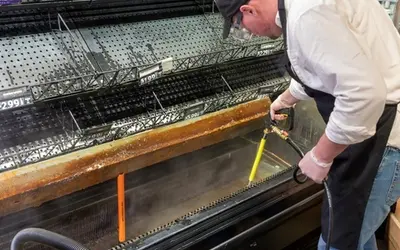How to Maximize Refrigerated Case Cleaning ROI

Grocery store managers analyze everything before approving any cleaning machine investment. Razor thin profit margins, ranging from 1 to 3 percent, make it hard to justify the cost of commercial cleaning equipment. Particularly when mops and buckets appear so cheap, at least at first. (Spoiler alert: Mops and buckets are way more expensive than you think. Read this article for more).
That’s why maintenance investment strategies consider return on investment (ROI) before each purchase. Obviously, a specialized tool has to get the cleaning job done. But a machine investment that also saves on labor time, energy costs, and service calls? That’s a triple win.
The Refrigerated Case Cleaner from Kaivac delivers that triple grocery store cleaning ROI every time your workers use it. Of course, the tool delivers sparkling clean, fresh smelling refrigerated cases–no small feat, considering how time consuming and unpleasant that job is. However, the tool also saves money on labor, energy, and outside service calls.
Here’s how the Refrigerated Case Cleaner from Kaivac boosts grocery store cleaning ROI in three vital ways.
Reduce Annual Energy Costs
Refrigeration consumes huge amounts of energy, about 43% of a grocery store’s total electricity usage according to this report. But that number is for clean refrigerated cases. Dusty refrigerated cases force components to work harder, sucking up even more energy, and sending your electricity bills sky high.
And it doesn’t take much to make a big difference. As little as 0.042” of dirt on condensing coils cause a 21% drop in efficiency, increasing energy use by 35%.
The Refrigerated Case Cleaner from Kaivac takes the hassle out of keeping coils clean and efficient, allowing your workers to service refrigerated cases like a pro. The result? Clean coils operating at peak efficiency. Power bills stay lower and expensive equipment lasts longer.
Reduce Labor Time
Using in-house labor to clean a refrigerated cases in house is not easy. The manual process eats up tons of time and requires a host of different tools. The job is so tedious, unpleasant, and time consuming that grocery managers find it hard to schedule. So, the task falls off the radar and refrigerated cases get dirtier and dirtier.
The Refrigerated Case Cleaner makes maintaining vital equipment easy. The advanced machine comes with everything your crew needs right on board. There’s no running around looking for tools. No making due with what they find. And no ignoring standard operating procedures set by your Food Safety Directors.
Yet, the Refrigerated Case Cleaner is easy to learn and operate. The tool is so simple and powerful that it cleans cases in half the time, cutting labor hours so workers can move on to other tasks. That makes the Refrigerated Case Cleaner a labor multiplier and a smart store cleanliness investment.
Reduce Service Calls
Reducing service calls is one of the best ways to boost grocery store cleaning ROI. Calling in a refrigeration expert is expensive, accounting for one/third of a grocery’s repairs and maintenance budget. This adds up to an average of $33,900 per location per year.
Cleaning refrigerated cases in-house cuts the need for expensive third-party maintenance and repairs. The Refrigerated Case Cleaner from Kaivac has everything your staff needs to stick to a regular cleaning schedule. This good maintenance habit keeps expensive equipment running at peak efficiency, extending its life, and reducing costly repair and maintenance calls.
Are you ready to maximize your grocery store cleaning ROI? The Refrigerated Case Cleaner from Kaivac delivers with reduced energy costs, reduced labor time, and reduced service calls.
Click here to learn more.

Amy Milshtein
Amy Milshtein is a seasoned writer and content strategist at Kaivac, Inc., where she combines her passion for storytelling with her extensive knowledge of cleaning technologies. With over a decade of experience in the industry, Amy has become an expert in translating complex technical concepts into engaging and accessible content. She holds a degree in English and Communication from Rutgers, the State University of NJ.
Related Posts

A System for Every Aisle: How Kaivac Delivers Complete Grocery Store Cleaning Solutions
Kaivac’s integrated Grocery Suite streamlines cleaning across every store zone, cutting labor, reducing cross-contamination, and delivering faster, deeper hygiene results for safer, fresher stores.
Read more
Give Grocery Store Refrigerators Regular Attention—Or Prepare for Failure
Clean grocery refrigerators save energy, prevent costly repairs, reduce food waste, and protect health. Kaivac’s solution stops the costly chain reaction caused by neglected case cleaning.
Read more